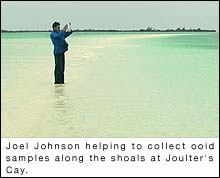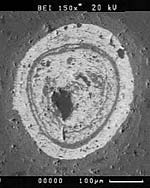A new research project was started
by Patricia M. Gregg, who is finishing up her first year at
MIT in the MIT/Woods
Hole Oceanographic Institution (WHOI)
Joint Program in Marine
Geology and Geophysics. Trish's primary research interests
lie in crust/mantle interactions and geodynamics at transform
faults and fracture zones.

Trish
is also working on a project that she and John Grotzinger developed
while conducting class-related field work in the
Three
Creeks area of Andros Island. We were able to visit
Joulters Cay and sample the famous ooid shoals, while formulating
questions about their formation and the time scale of the deposits.
There has been a fair amount of research performed on ooids
and their depositional environments. However, very little is
known in regards to how they form. Some questions we are looking
at include: given a population of ooids, when were they formed,
all at once or over a long period of time? Is there a relation
between ooid size and age? Are ooids measurably older at their
cores in contrast to their margins? Do ooids have distinct source
regions (marked by differing age), or do they all form simultaneously
over the entire shoal?

To answer these and many other questions, Trish has started
to prepare ooid samples to be analyzed using the Accelerator
Mass Spectrometer at
WHOI.
We will be micro-sampling the ooids using a technique developed
by Chris Weidman. This technique should allow us to date the
rings on an ooid and gain insight into the formation of an ooid
over time.
 Trish
is also working on a project that she and John Grotzinger developed
while conducting class-related field work in the Three
Creeks area of Andros Island. We were able to visit
Joulters Cay and sample the famous ooid shoals, while formulating
questions about their formation and the time scale of the deposits.
There has been a fair amount of research performed on ooids
and their depositional environments. However, very little is
known in regards to how they form. Some questions we are looking
at include: given a population of ooids, when were they formed,
all at once or over a long period of time? Is there a relation
between ooid size and age? Are ooids measurably older at their
cores in contrast to their margins? Do ooids have distinct source
regions (marked by differing age), or do they all form simultaneously
over the entire shoal?
Trish
is also working on a project that she and John Grotzinger developed
while conducting class-related field work in the Three
Creeks area of Andros Island. We were able to visit
Joulters Cay and sample the famous ooid shoals, while formulating
questions about their formation and the time scale of the deposits.
There has been a fair amount of research performed on ooids
and their depositional environments. However, very little is
known in regards to how they form. Some questions we are looking
at include: given a population of ooids, when were they formed,
all at once or over a long period of time? Is there a relation
between ooid size and age? Are ooids measurably older at their
cores in contrast to their margins? Do ooids have distinct source
regions (marked by differing age), or do they all form simultaneously
over the entire shoal? To answer these and many other questions, Trish has started
to prepare ooid samples to be analyzed using the Accelerator
Mass Spectrometer at WHOI.
We will be micro-sampling the ooids using a technique developed
by Chris Weidman. This technique should allow us to date the
rings on an ooid and gain insight into the formation of an ooid
over time.
To answer these and many other questions, Trish has started
to prepare ooid samples to be analyzed using the Accelerator
Mass Spectrometer at WHOI.
We will be micro-sampling the ooids using a technique developed
by Chris Weidman. This technique should allow us to date the
rings on an ooid and gain insight into the formation of an ooid
over time.
